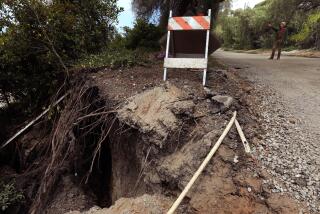Water Report Slanted to Back Growth, Agency Says : Antelope Valley: The U.S. analysis says supplies may not even be enough for current population.
A recent report by Los Angeles County officials concluding that the Antelope Valley has plentiful water supplies is inaccurate and misrepresents data in trying to prove the region can support much new development, according to a critique released Friday by a federal agency.
The unusually blunt analysis by the U.S. Geological Survey, the latest volley in a continuing debate over the high desert’s water resources, accused county officials of overstating the region’s water supplies and underestimating its demands, among other flaws.
Calling the county report “an unrealistic assessment,” the USGS critique contends it “misrepresents some of the published data and estimates for the Antelope Valley in trying to make a case that abundant Antelope Valley ground-water supplies exist for future Los Angeles County users.”
In response, a county official Friday defended the 15-page report, which was issued in March at the request of Supervisor Mike Antonovich. “The intent of that report was to get people’s attention, and it has,” said Gary Hartley, a top official with the county Waterworks Districts.
The debate over the Antelope Valley’s water resources has intensified in recent months because of the drought and the appearance of fissures in the earth due to sinking ground levels in Lancaster and at Edwards Air Force Base. Some scientists believe the cracks are caused by excessive ground-water pumping.
But what drives the debate are questions of growth and future development, because the high desert contains the largest areas of undeveloped land left in the county.
The geological survey critique is likely to provide more ammunition for residents who question whether the region’s water supply can support future growth or even the current 250,000 population.
In their own separate report in April, USGS officials and a group of Antelope Valley water agencies maintain that the valley is overdrafting its ground-water supplies. But county officials disagreed in their report.
According to the county’s report, the Antelope Valley pumped only 41,420 acre-feet of ground water in 1989, compared with an estimated average 58,000 acre-feet of water that it said is put back into the ground each year, mostly by runoff of rain and melted snow from the surrounding mountains.
Although admitting its assessment is “limited in scope and complexity,” the report by county waterworks officials contends that the Antelope Valley’s ground-water resources, along with imported state water, can easily support a population of more than 420,000.
However, the USGS said the county used inaccurately low estimates of water demand in the Los Angeles County portions of the Antelope Valley. And, the critique said, the county failed to include water use by Kern and San Bernardino county areas of the valley.
In addition, the USGS said the county overestimated the amount of water flowing into the underground supplies by at least 10,000 acre-feet per year because it depended on past research that covered a larger area than just the Antelope Valley. And the critique said future state water deliveries were overestimated by up to 60,000 acre-feet per year.
An acre-foot of water is about 326,000 gallons, enough to serve two typical households for a year. The USGS critique, prepared at the request of officials at Edwards Air Force Base, was released at a water symposium in Lancaster sponsored by the Antelope Valley Board of Trade.
More to Read
Sign up for Essential California
The most important California stories and recommendations in your inbox every morning.
You may occasionally receive promotional content from the Los Angeles Times.





